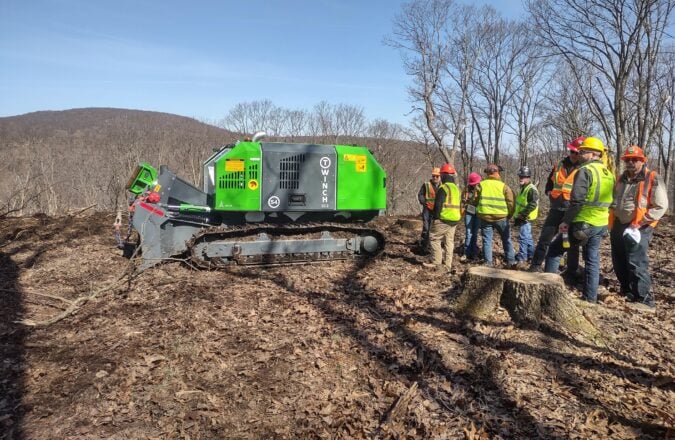Exploring Careers in Forestry: What Does a Timber Marketing Manager Do?

As the forest products market goes through its ups and downs, Rayonier’s timber marketing managers bring stability to the company by ensuring healthy sales regardless of changes in the economic environment.
Forestry careers offer a unique blend of working outdoors and contributing to environmental sustainability. In this article, we delve into the role of Timber Marketing Managers, their significance in forestry, and the pathways to becoming a part of this dynamic field.
What is the Role of a Timber Marketing Manager?
Timber marketing managers—or TMMs, as we like to call them—sell timber to sawmills, wood pulp businesses, log exporters and other buyers for companies like Rayonier. TMMs work to get the best possible value out of the trees we have invested in and nurtured for decades.

At a high level, tasks include:
- Developing and implementing strategies for a timber sale.
- Assessing the quality and quantity of timber resources.
- Understanding market demand and trends.
- Negotiating contracts with buyers.
- Ensuring harvesting practices align with sustainable forestry principles.
Timber marketing managers act as a bridge between forestry operations and the marketplace, aiming to maximize profitability while promoting responsible resource management.
The Importance of Timber Marketing Managers in Forestry
Timber marketing managers’ strategic decisions and adaptability contribute significantly to the overall health of the timber market.
Adapting to changing market dynamics is a cornerstone of the role. TMMs navigate challenging markets, overcome obstacles, and strategically position timber products to thrive in a dynamic environment, showcasing their resilience and strategic foresight.
“When Rayonier harvests timber, it needs to be sold no matter what the market conditions are,” says Kevin Pilemalm, our Senior Timber Marketing Manager on the Olympic Peninsula in Washington State.
Many factors affect timber sales, such as the overall economic climate, weather conditions that impact logging activities, and local production expenses. These factors are in constant flux and can affect costs and logistics. Our TMMs adapt to these changes to get our forest products to markets.
In addition to this mental calculus, TMMs manage long-standing relationships with loggers and buyers in their local communities, ensuring steady, productive business partnerships.
Kevin and the other TMMs admit this is a demanding role, but they also relish the challenge of it.
“It’s like a jigsaw puzzle,” says Casey LaCasse, one of our Timber Marketing Managers based in Northeast Florida. “You have to put all these pieces together to make the sale work.”
How Valuable is a Stand of Timber?
The value of a stand of timber depends on various factors. When determining value, Timber Marketing Managers assess the species composition, age, size and overall health of the forest stand.
“To sell timber, you need to have a strong understanding of the value of trees and what provides that value,” says Casey.
Many of our TMMs have been in forestry for decades and they understand the factors that impact timber values, such as tree species.
At Rayonier, we grow several different species. In the U.S. South, we grow pines such as loblolly, slash and longleaf, which require 20 to 25 years to mature. In Washington State and Oregon, hemlocks, firs, and hardwoods require more growing time—sometimes 40 years or more.
“In the Pacific Northwest, we grow cedars and other hardwoods,” says Kevin. “Some of our most valuable trees are export logs that we sell to local facilities to ship overseas.”
TMMs lead teams of foresters that evaluate each stand of trees to determine pricing. In addition to species, these foresters analyze other factors that affect value, including height, diameter, straightness, and quality.
Foresters record specifications for each stand of trees and TMMs use this data to find the right buyer.
TMMs often negotiate directly with prospective buyers, especially if they know a particular buyer’s needs. Other times, they use a bidding system in which they publish the data and buyers bid for the timber.
By understanding these factors, Timber Marketing Managers can ensure that the value of the timber is maximized.

The Value of Relationship Management in Timber Sales
Developing strong relationships is paramount for Timber Marketing Managers. TMMs engage in effective communication and negotiation to build trust and secure long-term partnerships with buyers, forestry teams, logging contractors, and other stakeholders in the wood product supply chain.
It’s critical that TMMs understand the value of timber and keep their finger on the pulse of the log market, but selling timber doesn’t come down to a simple math equation.
“The highest price doesn’t always get the log,” says Ian Thompson, another Senior Timber Marketing Manager on our Pacific Northwest team. “We have long-term relationships with our customers. I’m not going to pull wood away from one mill just because another customer we haven’t worked with in years comes up with a big offer that will only last two months.”
Ian works with about a dozen regular customers, many of them local mills that have a steady demand for our forest products.
“Everybody’s trying to be profitable and we’re all in this together,” he says. “We have to get through the down markets and thrive when the markets are good. It’s about nurturing those relationships, keeping them healthy.”
Hiring the right loggers for Timber Harvesting
Our TMMs also hire and coordinate with local logging businesses and trucking fleets to harvest our trees and deliver them to buyers. Developing healthy relationships with these companies is just as important to the overall success of timber sales.
When deciding which contractors to work with, TMMs look at several factors. Here again, it’s not a simple answer where the best bid gets the contract.
“Productivity is not number one,” says Ian. “First and foremost is safety. Then compliance with regulations and sustainable forestry initiatives. And then productivity comes next. We want them to be as productive as is feasible and reasonable. It comes down to hiring good contractors that understand the rules.”

Understanding the Impact of Timber Marketing Managers
Timber Marketing Managers play a crucial role in balancing economic goals and environmental sustainability.
They contribute to overseeing harvesting practices that minimize ecological impact and ensure compliance with certification standards like a Sustainable Forestry Initiative® certification. Sustainability standard compliance is a vital part of every stage of the forest lifecycle. Learn more about how forestry companies prove they’re sustainable by going behind the scenes on a recent sustainable forestry certification audit.
How Do You Become a Timber Marketer?
Becoming a Timber Marketing Manager (TMM) is a journey that requires a combination of formal education, practical experience and mentorship from industry leaders. The TMM role requires deep knowledge of forestry as well as communication and negotiation skills—a blend of attributes that takes time to develop.
Education needed to become a Timber Marketing Manager
Aspiring Timber Marketing Managers typically pursue degrees in forestry, natural resource management, or a related field. Relevant coursework may cover forest economics, marketing and sustainable forestry practices.
Many of our TMMs have degrees in forest management, which serve as the foundation they have built upon with their time in the industry.
This educational background equips them with the necessary tools to navigate the complex landscape of timber marketing.
Developing skills through Work Experience
Many of our TMMs have worked in forestry for decades. Chuck Beck, our TMM in Oklahoma, has been in forestry for 25 years and says his earlier experiences in silviculture (the science of growing trees) gave him a strong knowledge base to build on.
“I’ve gone through a full rotation,” he says. “That’s a unique situation to harvest trees that you planted—to get to see the outcome of those genetics.”
This work experience allows TMMs to intimately understand the entire lifecycle of the timber they market, enhancing their strategic decision-making.
Taking advantage of mentorship from Industry Leaders
A key component of career development is leveraging the invaluable insights and feedback from the leaders around you.
Ian started his career with the U.S. Forest Service. He worked on a timber marking crew, painting trees that were to be cut. He also served on a fire crew. And later he worked as a technician in private forestry, selecting trees for thinning operations.
He got negative feedback at one job when he marked trees that the timber cutter said were too close together. The trees’ crowns were intertwined, making it nearly impossible to harvest one without damaging the others.
“I got a lot of criticism as a young forester,” he says. “It was good because every bit of that helped me in moving forward.”
Ian also recommends negotiation courses for aspiring TMMs to develop the skills to relate with customers.
“Communication is key,” he says. “It’s important to ask questions and hear not just what the other person is telling you but also what they’re not telling you. It helps to understand their business needs.”
How do Aspiring Timber Marketing Managers get hands-on experience?
Gaining practical experience through internships is crucial, and we provide such opportunities through our summer internship programs.
These programs are designed to immerse upcoming foresters in the industry while providing valuable mentorship. Learn more about our internship programs here, and discover how you can be at the center of the action, gaining insights that will shape your future in timber marketing.

Future Opportunities in Timber Sales
The future of timber marketing holds exciting opportunities, including technological advancements and sustainable forest management practices.
Kevin, our Senior TMM in Washington State, says the forestry workforce is aging and will need new talent to fill these roles in coming years.
“Forestry is a good way to earn a living and support a family,” he says.
He and the other TMMs look forward to welcoming young foresters who want to broaden their skills and learn how to make the most out of every tree we grow.
We hope this article helped you understand the Timber Marketing Manager’s role, including a comprehensive understanding of the career path, responsibilities, and impact associated with forestry careers in timber marketing. If you’re interested in a TMM career at Rayonier, you can learn more about working for us at rayonier.com/careers.

This article was originally published by Rayonier Stories. Find the article here: www.rayonier.com/stories


